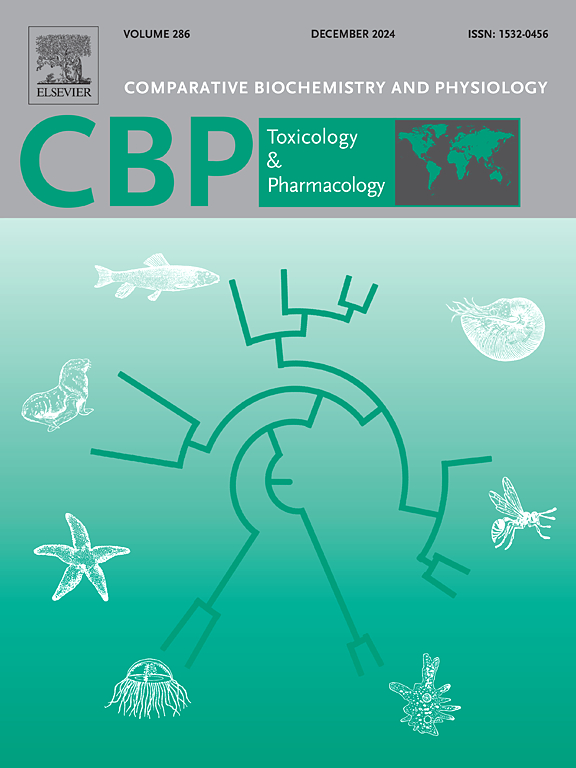磷酸三正丁酯(TnBP)和磷酸三酰基(TCP)对大肠杆菌毒性作用的机制理解:来自生物标志物表达改变和代谢网络扰动的证据
IF 3.9
3区 环境科学与生态学
Q2 BIOCHEMISTRY & MOLECULAR BIOLOGY
Comparative Biochemistry and Physiology C-toxicology & Pharmacology
Pub Date : 2025-04-24
DOI:10.1016/j.cbpc.2025.110211
引用次数: 0
摘要
磷酸三正丁酯(TnBP)和磷酸三甲苯酯(TCP)作为新兴的阻燃剂和增塑剂,因其对生态系统的潜在风险而受到越来越多的关注。有关 TnBP 和 TCP 毒理学机制的研究为数不多,而其分子水平的毒性效应以及利用微生物模型进行的代谢反应则缺乏相关研究。因此,我们研究了暴露于 TnBP 和 TCP 的大肠杆菌的细胞毒性、氧化应激反应和代谢反应。暴露于这两种物质后,抗氧化酶的活性明显增加,表明抗氧化防御系统被激活。活性氧(ROS)的过度积累引发了各种生物事件,包括膜电位(MP)降低、腺苷三磷酸酶(ATPase)活性降低和丙二醛(MDA)含量增加。这些发现表明,氧化损伤损害了膜蛋白功能、膜稳定性和细胞内平衡。基于 GC-MS 和 LC-MS 的代谢组学分析表明,TnBP 和 TCP 严重破坏了多种代谢途径,包括碳水化合物代谢、核苷酸代谢、脂质代谢、β-丙氨酸代谢、丙酮酸代谢和氧化磷酸化。这些干扰凸显了对分子功能和代谢过程的抑制作用。值得注意的是,脂质生物标志物,如 PC(11:0/16:0)、PA(17:1(9Z)/18:2(9Z,12Z))、PE(17:0/14:1(9Z))和 LysoPE(0:0/18:1(11Z))发生了显著变化,验证了脂质相关代谢物合成的调控在维持细胞膜功能方面起着保护作用。总之,本研究加深了我们对 TnBP 和 TCP 在大肠杆菌中毒性的理解,从分子和网络水平上提供了对其毒性机制的新见解。这些发现强调了有机磷阻燃剂在水生生态系统中造成的生态风险。本文章由计算机程序翻译,如有差异,请以英文原文为准。

Mechanistic understanding of the toxic effects of tri-n-butyl phosphate (TnBP) and tricresyl phosphate (TCP) to Escherichia coli: Evidence from alterations in biomarker expression and perturbations of the metabolic network
Tri-n-butyl phosphate (TnBP) and tricresyl phosphate (TCP), emerging flame retardants and plasticizers, have garnered increasing attention due to their potential risks to ecosystem. A few researches regarding the toxicological mechanisms of TnBP and TCP had been performed, while molecular-level toxic effects of them and metabolic response using microbial models are the lack of relevant investigation. Thus, we investigated the cytotoxicity, oxidative stress response, and metabolic response in E. coli exposed to TnBP and TCP. Exposure to them significantly increased the activities of antioxidant enzymes, indicating activation of the antioxidant defense system. Excessive accumulation of reactive oxygen species (ROS) triggered various biological events, including a reduction in membrane potential (MP), decrease of adenosine triphosphatase (ATPase) activity, and increased malondialdehyde (MDA) content. These findings suggested that oxidative damage compromised membrane proteins function, membrane stability, and intracellular homeostasis. GC–MS and LC-MS-based metabolomics analyses revealed that TnBP and TCP strongly disrupted multiple metabolic pathways, including carbohydrate metabolism, nucleotide metabolism, lipid metabolism, beta-alanine metabolism, pyruvate metabolism and oxidative phosphorylation. These disruptions highlighted the inhibitory effects on molecular functions and metabolic processes. Notably, lipids biomarkers e.g., PC(11:0/16:0), PA(17:1(9Z)/18:2(9Z,12Z)), PE(17:0/14:1(9Z)), and LysoPE(0:0/18:1(11Z)) were significantly altered, verifying that the regulation of lipid-associated metabolite synthesis plays a protective role in maintaining cellular membrane function. In summary, this study enhances our understanding of TnBP and TCP toxicity in E. coli, providing novel insights into their toxicological mechanisms at molecular and network levels. These findings underscore the ecological risks posed by organophosphate flame retardants in aquatic ecosystem.
求助全文
通过发布文献求助,成功后即可免费获取论文全文。
去求助
来源期刊
CiteScore
7.50
自引率
5.10%
发文量
206
审稿时长
30 days
期刊介绍:
Part C: Toxicology and Pharmacology. This journal is concerned with chemical and drug action at different levels of organization, biotransformation of xenobiotics, mechanisms of toxicity, including reactive oxygen species and carcinogenesis, endocrine disruptors, natural products chemistry, and signal transduction with a molecular approach to these fields.

 求助内容:
求助内容: 应助结果提醒方式:
应助结果提醒方式:


